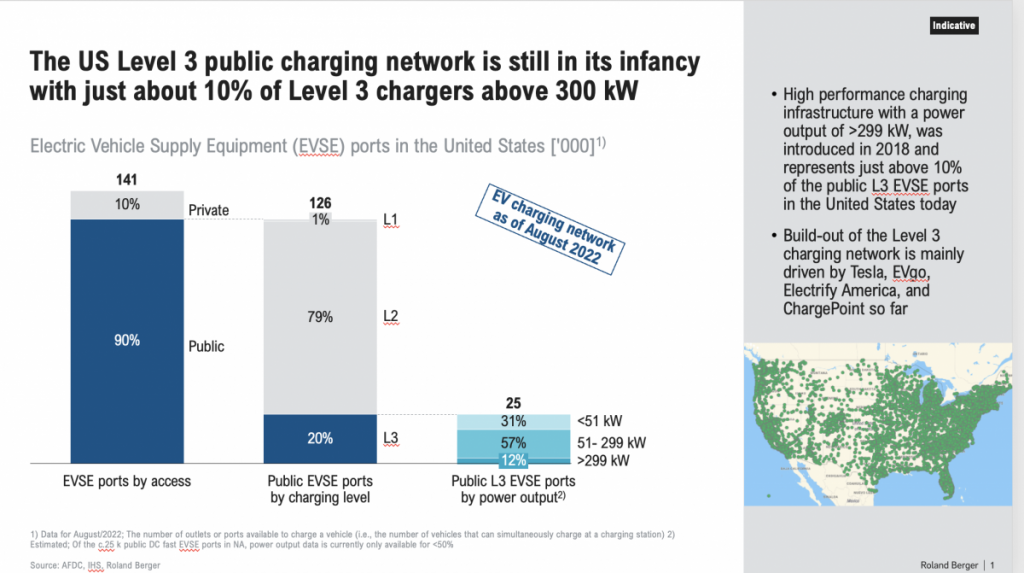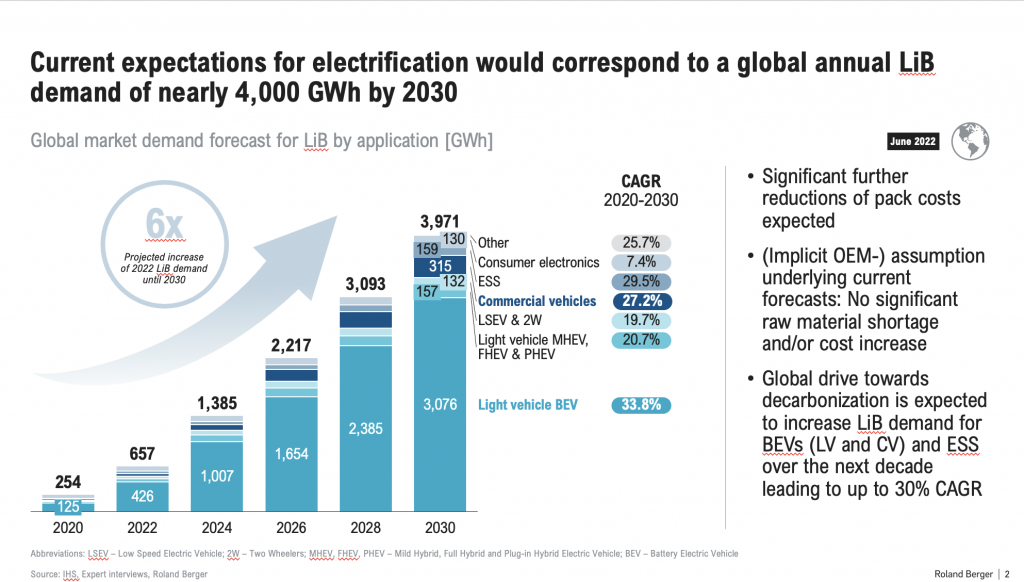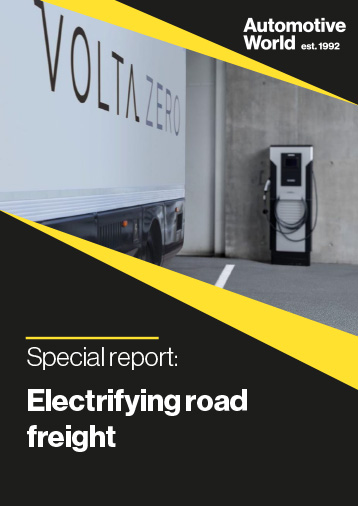The environment for freight electrification, be it via battery electric vehicles of fuel cells, has never been so positive. Even in the US, a market often associated with a rather measured approach towards a de-carbonised future, things have decidedly turned a corner.
On the regulation side, the environment is positive not only at the state level (led by California) but also at the federal level with the recent Inflation Reduction Act providing significant incentives for fleet electrification and infrastructure construction. Customer demand is strong. Many fleets have identified their emission reduction targets, and the leaders have committed to carbon neutral or even net zero operations by 2035-2050. Their desire to decarbonise transport reflects the expectations of their key stakeholders—investors, end customers and employees. Based on Roland Berger’s observations, many fleets are even pulling forward their de-carbonisation targets by four to six quarters.
Technology development is also moving in the right direction. Battery technology is maturing and lower cost alternatives such as LFPM technology promise cost-efficient operation for use cases not only in passenger cars and buses but also in some commercial vehicle applications. On the fuel cell side, the drive to either develop commercial vehicle focused powertrains or to adapt passenger vehicle technology to commercial vehicle duty cycles is on. Remaining challenges should be largely addressed by the end of this decade.

What then is holding us back to move boldly into the new, de-carbonised future? Two main challenges remain that require multi-stakeholder co-operation and investment. On the one hand, the build up of adequate infrastructure is key. For return to base operations or dedicated routes between two warehouses, the investment requirements are likely to be borne by carriers or infrastructure partners. Here, having charging or hydrogen refuelling on-site gives the operator full control over site access, charger type, and timing. Also, the cost of fuel is lower than at public stations that need to recoup investments and make a profit. Yet, new capabilities around, for example, vehicle-to-grid charging or green energy implementation have to be built up.
On-route charging/re-fuelling or opportunity charging/re-fuelling requires a public network that enables battery electric and fuel cell trucks to fill up during transit as a means to extend range. Early initiatives are on the way, e.g., the effort along the I-5 in California. Most of these initiatives are currently state and utility driven with the first commercial vehicle OEMs getting into the fray. Key challenges that need to be addressed include interoperability testing, authentication and billing. Also, commercial vehicles need high-power L3 chargers, which are hard to come by. As shown in the graph below, a paltry fraction of all public chargers in the US are relevant L3 chargers with more than 300 kW.

The other concerns centre around the availability of key inputs. Take battery electric vehicles as an example. Current projections for BEV penetration indicate a CAGR of about 30% between 2020 and 2030, i.e., a six-fold increase in demand from today until the end of the decade.
Clearly, such exponential growth is likely to lead to bottlenecks from the perspective of access to key battery raw materials (Li, Ni, Co, Mn, graphite) as well as copper as adequate mining and refining capacities will take time to build up. Similarly, battery cell production may not keep up with demand in the mid-term. Similar questions exist around the availability and price points of blue or green hydrogen. While Roland Berger believes that these concerns will be addressed, it is important to understand the challenges, take pre-emptive measures and watch the development closely.
Lastly, the electrification journey for fleets isn’t a simple undertaking either. Based on our work with several fleets, it is clear that we are talking about a major transformation that includes internal as well as external stakeholders. Fleets understand the basic application profiles of electric and hydrogen vehicles, hydrogen being advantageous for long range and high-variability operations. Yet translating general understanding into the details of the fleets routes and operations takes careful deliberation. As the transition is costly and capital intensive, being able to tap into the right funding pools is a must.

Understanding the impact that your operations have on the environment requires detailed baselining, i.e., the analysis of the current energy consumption/emissions as well as future consumption and emissions based on business development projections. With this baseline, companies can move towards setting decarbonisation targets. It is important to set these targets while understanding which measures can be deployed to avoid, reduce or off-set emissions. Committing to targets without knowing how to get there is dangerous as the likelihood of over-promising and under-delivering is high.
Part of the decarbonisation journey will have to include moving a significant fraction of each fleet to battery electric or hydrogen vehicles. Finding the right routes, applications and vehicles is crucial. Ideally, vehicles should be custom-made for specific applications and routes (e.g., last mile delivery). Yet we have to be conscious that complexity needs to be kept to a manageable level. After all, fleets need to train their workforce to maintain and repair electric vehicles, parts inventories need to be at acceptable levels and vehicles need to be integrated into new fleet management solutions. Beyond training their own employees, fleets need to be mindful of external stakeholders as well. In one case, one of our customers spent a significant amount of time and effort in training first responders on how to handle their electric vehicles.
Lastly, securing best cost access to charging infrastructure and green electrons and/or molecules is key to successfully making the transition. This will require engagement with a large ecosystem of players including OEMs, charging solutions providers, utilities, infrastructure companies, etc. There are a number of players competing in the area of fleet sustainability management services—OEMs (incumbent and start-up), charging infrastructure providers, utility providers, software providers, civil works/services players, spare parts players, renewable energy players, etc. The landscape is complex and evolving, and a clear leader among business models and companies has not been found yet.
Part of the decarbonisation journey will have to include moving a significant fraction of each fleet to battery electric or hydrogen vehicles
Overall, fleets need to invest in a new set of complex capabilities and activities if they want to manage and operate decarbonised fleets. Advanced analytics, build up of procurement scale and purchasing power, employee training, frequent regulations, policy and subsidy tracking are some of the areas that need close attention as fleets move through their decarbonisation journey. Not all of these capabilities may have to be fully in-house and we are seeing different sourcing and partnership approaches across various logistics players.
One thing is certain, decarbonised fleet operators and the energy and transportation ecosystem that they operate in will be very different in a few years time. It is time to tackle and manage this transformation and to get ahead of the curve.
About the Authors: Wilfried G Aulbur is Senior Partner, Walter Rentzsch is Director, Rahul Gangal is Senior Partner, Frank Pietras is Partner and Wenbo Yu is Partner at Roland Berger




